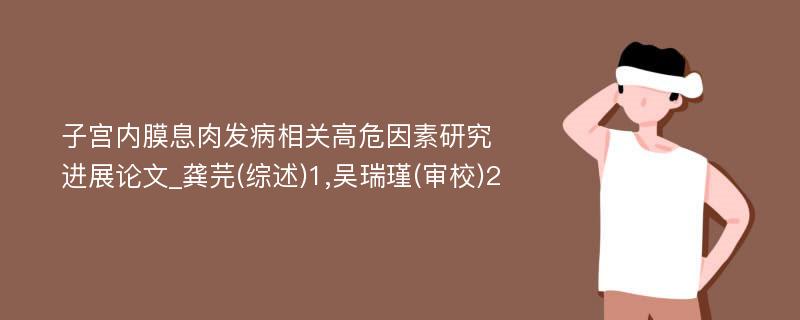
(1贵州省人民医院妇科 贵州 贵阳 550000)
(2浙江大学医学院附属妇产科医院 浙江 杭州 310006)
【摘要】 子宫内膜息肉是女性常见的子宫内膜病变,其发生原因和发病机制至今尚未清楚。EP的发病机制涉及激素、炎症、凋亡、基因等多因素,而与发病相关高危因素包括绝经、肥胖、激素替代治疗等,但都尚未定论。该文将从子宫内膜息肉发病相关的多种高危因素做一综述,更全面、准确地揭示子宫内膜息肉发生的特点,以更好地指导进一步的临床实验研究及疾病的预防和治疗。
【关键词】 子宫内膜息肉;高危因素;发病机制
【中图分类号】R71 【文献标识码】A 【文章编号】2095-1752(2015)16-0007-03
The research progress of risk factors of endometrial polyps
Gong Yuan. Guizhou People's Hospital, Guizhou Province, Guiyang 550000, China;
Wu Ruijin. Women’s Hospital, Zhejiang University School of Medicine,Zhejiang Province, Hangzhou 310006.China
【Abstract】 Endometrial polyp(EP) is one of the most common endometrial diseases in women. The pathogenesis of EP is still unknown, neither are the risk factors. Hormone level, chronic inflammation, cell apoptosis and gene mutation are considered involving in the pathogenic processes. Postmenopausal status, overweight/obesity and hormone replacement therapy have been suggested as related factors of EP. The accurate mechanism remains unclear.This is a review about risk factors and related mechanism of EP.
【key words】Endometrial polyps;Risk factors;Pathogenesis
子宫内膜息肉(endometrial polyp,EP)是女性最常见的子宫内膜病变之一,可发生于任何年龄妇女,随激素变化、药物使用、高血压、肥胖等情况不同而有变化,在妇女中的总发病率约为25%[1],绝经后妇女发病率高达3l%,高峰年龄为50岁[2] [3]。EP的发病机制涉及激素水平、炎性刺激、细胞凋亡、基因突变等,而高危因素种类繁多,包括绝经、肥胖、激素替代治疗等,但都尚未定论。
1.年龄
有学者提出,随着年龄的增长,女性患子宫内膜息肉风险将增高。Nappi等[4]通过宫腔镜检查评估353个有异常子宫出血、不孕及宫颈息肉的妇女,其中134例(38%)证实为EP,通过单因素分析得出EP的发生与年龄、绝经、高血压、肥胖、糖尿病有关,而行多因素回归分析后发现,与EP发病相关的仅年龄一个因素。而罗雪梅等[5]采用同样方法,得出研究组与对照组在年龄之间无明显差异;Bakour等[6]的一项前瞻性队列研究同样认为年龄与EP发病之间无明显关联。年龄因素易受到激素水平、慢性炎症持续时间等因素影响,且与实验对照组选取有关,从而影响结果观察。
2.激素替代治疗
有学者认为激素替代治疗为绝经女性EP发病的相关危险因素[7];McGurgan等[8]将已证实为EP的患者分为接受 HRT 治疗组和未经 HRT 治疗组,通过半定量免疫组化分析得出,HRT可通过抑制细胞凋亡从而形成息肉。Taylor及Oguz等学者提出EP的发生主要以子宫内膜局部雌孕激素受体失衡为主[9] [10]。孕激素的抗雌激素作用可对EP形成起到一定抑制作用。近年来有学者提出曼月乐(左炔诺孕酮宫内节育器系统)可用于宫腔镜术后EP复发的预防。因其能局部微量连续释放左炔诺孕酮,通过对抗雌激素抑制内膜增生,使子宫内膜腺体萎缩,间质水肿,血管受抑制,导致子宫内膜变薄,最终表现出显著的抑制内膜增生的作用[11]。另外,Oguz等[10]还提出,雌激素受体数量增多以及子宫内膜对雌激素的敏感性增高都可放大雌激素效能,从而促进内膜增殖和息肉形成。
3.他莫昔芬及米非司酮的应用
他莫昔芬(tamoxifen, TAM)是一种抗雌激素药物,它通过竞争性结合雌激素受体、干扰细胞内生物代谢、抑制肿瘤细胞增生而被广泛应用于乳腺癌术后的临床治疗。1993年,Cohen 等[12]阐述了使用TAM的绝经后乳腺癌妇女子宫内膜改变。有学者提出,TAM 除有抗雌激素作用外,尚有潜在的微弱的雌激素作用,若内源性雌激素活性较高,其呈现抗雌激素作用,若内源性雌激素活性降低则呈现雌激素激动剂作用,可诱导雌激素受体(estrogen receptor,ER)与孕激素受体(progesterone receptor,PR)在内膜的表达。Cohen等[13] [14]随后研究也进一步证实了绝经后使用TAM的妇女,子宫内膜息肉发生率增高,且绝经后服用TAM妇女的子宫内膜病理改变直接与服用TAM的时间和累计剂量相关。研究纳入因乳腺癌使用TAM的绝经后患者264例,经统计54例(20.5%)患者诊断子宫内膜息肉,当服用 TAM 的时间超过48个月时,子宫内膜息肉的发生率明显增加。McGurgan等[15]提出TAM对子宫内膜雌激素受体及细胞凋亡标志物有着显著的作用,其作用为抑制细胞凋亡,从而促进内膜息肉生长。日本的Dibi等[16]对口服TAM的乳腺癌妇女行宫腔镜及病理学检查,发现EP发生率为32.5%,术后通过免疫组化方法检测到所有子宫内膜息肉ER均为阳性(P=0.019),由此可推测,TAM是子宫内膜息肉的易发因素,而ER可能在其中起关键作用。
米非司酮为一种对受体有高亲和力的抗孕激素药物,可在受体水平阻止孕酮与其受体结合,从而阻碍孕酮对子宫内膜的抑制生长作用。米非司酮以抗早孕药物开始应用于临床,近年来也用于一些激素依赖性疾病的治疗,如子宫肌瘤、子宫内膜异位症,并取得了一定的疗效[17]。Narvekar 等[18]研究认为米非司酮通过上调雄激素受体的活性及抑制子宫内膜增生期的有丝分裂达到抑制子宫内膜增生的作用。Steinauer 等[19]提出连续服用米非司酮(5mg/d)6个月后,子宫内膜病理结果提示腺上皮和间质细胞的有丝分裂象多见,且部分患者表现出与孕激素水平低下相一致的慢性无对抗雌激素效应。吴小容等[20]对160例被宫腔镜确诊为EP复发的患者行大剂量米非司酮(RU486 150 mg/d)治疗,其中105例EP消失,55例EP体积较前缩小30%~55%,EP中ER、PR及Ki-67的表达在用RU486后均较用前显著降低(P<0.05),研究推测,大剂量米非司酮对EP治疗有效,该作用与其降调EP中ER、PR、Ki-67的表达有关。
4.宫内节育器
宫内节育器(intrauterine device,IUD)作为异物,可能是刺激子宫内膜息肉形成的因素。陈丽玉等[21]对1357例年龄20~60岁女性行宫腔镜取环术,经手术及术后病理诊断,IUD合并EP者285例。子宫内膜息肉位于IUD的周围发病率最高,占33. 33% (P<0.01),?zalp等[22]研究了58例放置宫内节育器后出现阴道异常流血的妇女,其中8例出现子宫内膜增生,1例为子宫内膜息肉。而闫丽华等[23]对85例EP患者进行了发病有关因素分析,其中IUD位置下移或变形经多因素非条件logistic回归提示与EP发病有关(RR=5.45,95%CI:1.79-16.62)。IUD长期机械刺激作用可引起子宫内膜慢性、轻度、非细菌性炎性反应,引起子宫内膜息肉;同时,宫内节育器可刺激宫腔内膜产生前列腺素,从而使子宫、输卵管收缩蠕动异常,增加子宫内膜中的雌激素受体量,宫腔内高雌激素状态可刺激子宫内膜局限性增生形成息肉;另外,IUD的活性物质作用,可以致子宫内膜、宫腔液等内环境发生局部变化 [21]。
5.肥胖
Eva Dreisler等[7]在丹麦绝经妇女中发现超重是EP发生的高危因素之一。Indraccolo等[4]对246篇EP发病相关因素文章进行半定量系统回顾研究,得出对EP发病有促进作用的因素之一为超重或肥胖,研究中将肥胖与子宫内膜息肉发病的关系归为激素相关作用。脂肪组织产生的芳香化酶可将雄激素转换为雌酮及雌二醇,与此同时,且随着体重增加,血清激素结合球蛋白水平下降,而激素结合球蛋白可与血清游离雌激素和睾酮结合,降低激素活性,因此,球蛋白水平的下降就放大了剩余雌激素作用,通过上述途径,肥胖可影响类固醇激素的生物活性水平,雌激素水平升高、失衡进一步引起子宫内膜病变 [24,25,26]。
6.妊娠次数
妊娠次数与EP形成的关系仍在研究中。一些学者在单因素分析中得到了孕次或产次与EP有关,而进一步多因素回归分析中确未得到证实[5][23]。王晓燕等[27]对84例体外受精原胚胎移植后早期自然流产患者行宫腔镜检查,发现子宫内膜息肉12例(占14.29%)。原发不孕是妊娠因素中一种特殊形式。子宫内膜息肉可导致不孕,而对于原发不孕与EP形成的相关性,目前仍有争议[28]。Antonio Mollo等[29]发现不孕的EP患者中血清和内膜局部INF-γ水平显著高于不伴EP的不孕患者,因此推测,INF-γ等炎性因子不仅是EP形成的相关因子,也是不孕和EP之间关联的重要因素。
7.绝经
罗雪梅等[5]多因素回归分析发现绝经为引起EP的第二位危险因素。绝经妇女血循环中雌激素主要由肾上腺皮质产生的雄烯二酮在外周脂肪组织中储存、转换为雌酮,作用于人体。绝经后EP的发生,也是由雌酮作用于子官内膜所致。McGurgan等[30]研究绝经前后EP患者子宫内膜生理学差异,结果提示,绝经后妇女子宫内膜雌激素受体、孕激素受体水平上调,考虑与绝经后妇女内源性激素水平下降有关。雌、孕激素受体水平的改变,可能对绝经后妇女EP形成有一定作用。而彭雪冰等[31]研究发现绝经期妇女子宫内膜息肉病因与非绝经期是不同的,绝经期子宫内膜息肉的形成可能与激素受体水平不相关,考虑为组织的异常增生等其他因素。
8.子宫内膜异位症
Park等[32]研究了631个不孕的妇女,其中434个子宫内膜异位症患者中同时合并子宫内膜息肉的为63%。子宫内膜息肉在子宫内膜异位症的I期、Ⅱ期、Ⅲ期和Ⅳ期的发病率分别是54.2%、64.4%,67.6%和70.2%,通过线性分析,显示出他们之间是有差异的。因此研究提出子宫内膜异位症增加了子宫内膜息肉的发病率。Kontoravdis A等[33]也提出,卵巢子宫内膜异位症的患者EP的发病率升高。
除上述因素外,可能与 EP发病相关的高危因素还有:代谢性疾病、月经不调,其他部位息肉史等,均未定论。综上所述,激素替代疗法可能为EP发病高危因素,已经得到大多学者认同,肥胖可通过影响雌激素水平致子宫内膜病变,而其他相关因素相关性及其作用机制尚待进一步研究证实。
期刊文章分类查询,尽在期刊图书馆
【参考文献】
[1] Fambrini M, Buccolieroy AM, Bargelli G, et al. Clinical utility of liquid-based cytology for the characterization and management of endometrial polyps in postmenopausal age [J]. Int J Gynecol Cancer, 2008, 18(12):306-311.
[2] Goldstein SR, Monteagudo A, Popiolek D, et al. Evaluation of endometrial polyps [J]. Am J Obstet Gynecol, 2002, 186(4):669-674.
[3] Indraccolo U, Di Iorio R, Matteo M, et al. The pathogenesis of endometrial polyps: a systematic semi-quantitative review [J]. European journal, 2013, 34(1): 4.
[4] Nappi L, Indraccolo U, Spiezio SA, et al. Are diabetes, hypertension, and obesity independent risk factors for endometrial polyps? [J] Minim Invasive Gynecol, 2009, 16(2):157-162.
[5] 罗雪梅,程秋蓉,孟晓军等, 子宫内膜息肉发病的相关因素研究, 中国全科医学,2010年 第06期.
[6] S.H. Bakour, J.K. Gupta, K.S. Khan, Risk factors associated with endometrial polyps in abnormal uterine bleeding. Menopause, 2003, 10:534-537.
[7] Eva Dreisler,Soren Stampe Sorensen, Gunnar Lose. Endometrial polyps and associated factors in Danish women aged 36-74 years. Am J Obstet Gynecol. 2009 Feb; 200(2):147.
[8] McGurqan P, TayorL J, Duffy S R, et al. An immunohistochemical comparison of endometrial polyps from postmenopausal women exposed and not exposed to HRT. M aturitas, 2006, 53 (4): 454-461.
[9] Taylor L J, Jackson T L, Reid J G, et al. The differential expression of oestrogen receptors, progesterone receptors, Bcl‐2 and Ki67 in endometrial polyps[J]. BJOG: An International Journal of Obstetrics & Gynaecology, 2003, 110(9): 794-798.
[10] Oguz S, Sargin A, Kelekci S, et al. The role of hormone replacement therapy in endometrial polyp formation. Maturitas, 2005, 50: 231-236.
[11] Varma R, Soneja H, Bhatia K, et al. The effectiveness of a levonorgestrel-releasing intrauterine system (LNG-IUS) in the treatment of endometrial hyperplasia: a long-term follow-up study [J]. European journal of obstetrics, gynecology, and reproductive biology, 2008, 139(2): 169-175.
[12] Cohen I, D.J. Rosen, Shapira J,et al. Endometrial changes in postmenopausal women treated with tamoxifen for breast cancer. Br J Obstet Gynecol, 100 (1993), pp. 567–570.
[13] Cohen I, Azaria R, Shapira J, et al. The significance of secondary ultrasonographic endometrial thickening in postmenopausal tamoxifen-treated women. Cancer, 2002, 94:3101-3106.
[14] Cohen I. Endometrial pathologies associated with postmenopausal tamoxifen treatment. Gynecol Oncol, 2004, 94(2): 256-266
[15] McGurgan P, Taylor L J, Duffy S R, et al. Does tamoxifen therapy affect the hormone receptor expression and cell proliferation indices of endometrial polyps? An immunohistochemical comparison of endometrial polyps from postmenopausal women exposed and not exposed to tamoxifen[J]. Maturitas, 2006, 54(3): 252-259.
[16] Dibi RP, Zettler CG, Peesini SA, et a1,Tsmoxifen use and endometrial lesions: hysteroscopic,histological, and immunohistochemical findings in postmenopausal women with breast cancer. Menopause, 2009, 16:293-300.
[17] Spitz I M. Mifepristone: where do we come from and where are we going: Clinical development over a quarter of a century [J]. Contraception, 2010, 82(5): 442-452.
[18] Narvekar N, Cameron S, C ritchley H O, et al. Low-dose mifepristone inhibits endometrial proliferation and up-regulates androgen receptor. J Clin Endocrinol Metab, 2004, 89 (5): 2491-2497
[19] Steinauer J, Pritts E A, Jackson R, et al. Systematic review of mifepristone for the treatment of uterine leiomyomata. Obstet Gynecol, 2004, 103 (6): 1331-1336
[20] 吴小容. 大剂量米非司酮对绝经后子宫内膜息肉的雌, 孕激素受体及 Ki-67, Bcl-2 的影响 [J]. 中国医药导报, 2008, 5(17): 40-41.
[21]陈丽玉 张其清 金利华等,IUD与子宫内膜息肉相关性的研究,现代妇产科进展2009, 18(2):132-135
[22]?zalp S, Kabukcuoglu S, Tanir H M. Should endometrial hyperplasia be regarded as a reason for abnormal uterine bleeding in users of the intrauterine contraceptive device?[J]. European J. of Contraception and Reproductive Healthcare, 2003, 8(1): 17-20.
[23]闫丽华 刘海燕 邢佑红.子宫内膜息肉有关因素分析.中国妇幼健康研究. 2011, 22(6):788-789,808.
[24] Carlson M J, Thiel K W, Yang S, et al. Catch it before it kills: progesterone, obesity, and the prevention of endometrial cancer[J]. Discovery medicine, 2012, 14(76): 215-222.
[25] Cauley JA, Gutai JP, Kuller LH, et al. The epidemiology of serum sex hormones in postmenopausal women. Am J Epidemiol, 1989, 129:1120-1131.
[26] Schmandt RE, Iglesias DA, Co NN, et al. Understanding obesity and endometrial cancer risk: opportunities for prevention. AJOG, 2011, 205(6):518-525.
[27]王晓燕,李政,阿艳妮等。体外受精-胚胎移植后早期自然流产患者宫腔镜诊治及再次妊娠结局分析[J].中华男科学杂志,2011,17(1):52-54.
[28] Afifi K, Anand S, Nallapeta S, et al. Management of endometrial polyps in subfertile women:a systematic review. Eur J Obstet Gynecol Reprod Biol 2010; 151:117–21.
[29] Mollo A, Stile A, Alviggi C, et al. Endometrial polyps in infertile patients: do high concentrations of interferon-gamma play a role? [J]. Fertility and sterility, 2011, 96(5): 1209-1212.
[30] McGurgan P, Taylor L J, Duffy S R, et al. Are endometrial polyps from pre-menopausal women similar to post-menopausal women? An immunohistochemical comparison of endometrial polyps from pre-and post-menopausal women [J]. Maturitas, 2006, 54(3): 277-284.
[31] 彭雪冰. 绝经期妇女子宫内膜息肉中雌激素受体, 孕激素受体的表达特点及意义 [J]. 医学信息, 2011, 24(8).
[32] Park J S, Lee J H, Kim M, et al. Endometrium from women with endometriosis shows increased proliferation activity [J]. Fertility and sterility, 2009, 92(4): 1246-1249.
[33]Kontoravdis A, Augoulea A, Lambrinoudaki I, et al. Ovarian endometriosis associated with ovarian cancer and endometrial–endocervical polyps [J]. Journal of Obstetrics and Gynaecology Research, 2007, 33(3): 294-298.
论文作者:龚芫(综述)1,吴瑞瑾(审校)2
论文发表刊物:《医药前沿》2015年第16期供稿
论文发表时间:2015/8/7
标签:息肉论文; 子宫内膜论文; 雌激素论文; 因素论文; 受体论文; 内膜论文; 作用论文; 《医药前沿》2015年第16期供稿论文;
